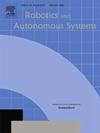Quadrotors’ perching on moving inclined surfaces using uncertainty tolerant planner and thrust regulation
IF 4.3
2区 计算机科学
Q1 AUTOMATION & CONTROL SYSTEMS
引用次数: 0
Abstract
Quadrotors with the ability to perch on moving inclined surfaces can save energy and extend their travel distance by leveraging ground vehicles. Achieving dynamic perching places high demands on the performance of trajectory planning and tracking control in SE(3). However, in the perching process, uncertainties in target prediction and tracking errors may cause trajectory planning failure. And, independent control of position and attitude is also difficult for underactuated quadrotors. To address these challenges, we first propose a trajectory planner that considers adaptation to uncertainties in target prediction and tracking errors. In the planner, waypoints are optimized using the average coverage of their reachable set over the uncertain target as a criterion. A real-time trajectory planner based on optimized waypoints is developed accordingly. Secondly, thrust regulation is also implemented in the terminal attitude tracking stage. Therefore, positions and velocities can be controlled simultaneously when a quadrotor’s attitudes are commanded to align with surfaces. Extensive simulation experiments demonstrate that our methods can improve the accuracy of terminal states under uncertainties. The success rate is approximately increased by 50% compared to the two-end planner without using thrust regulation. Perching on the rear window of a car is also achieved outdoors to validate the feasibility and practicality of our methods.

基于不确定性容限规划和推力调节的四旋翼飞行器在运动斜面上的悬停
四旋翼机能够栖息在移动的倾斜表面上,可以节省能源,并通过利用地面车辆延长其旅行距离。实现动态停泊对SE(3)的轨迹规划和跟踪控制性能提出了很高的要求。然而,在着陆过程中,目标预测的不确定性和跟踪误差可能导致轨迹规划失败。欠驱动四旋翼机的位置和姿态独立控制也是一个难题。为了解决这些挑战,我们首先提出了一种考虑目标预测和跟踪误差不确定性的轨迹规划器。在规划器中,以可达集对不确定目标的平均覆盖范围作为准则对航路点进行优化。据此开发了基于优化航路点的实时轨迹规划器。其次,在末端姿态跟踪阶段也实现了推力调节。因此,位置和速度可以同时控制,当一个四旋翼的态度被命令与表面对齐。大量的仿真实验表明,我们的方法可以提高不确定情况下终端状态的精度。与不使用推力调节的两头规划器相比,成功率大约提高了50%。在室外也实现了汽车后窗上的栖息,验证了我们方法的可行性和实用性。
本文章由计算机程序翻译,如有差异,请以英文原文为准。
求助全文
约1分钟内获得全文
求助全文
来源期刊

Robotics and Autonomous Systems
工程技术-机器人学
CiteScore
9.00
自引率
7.00%
发文量
164
审稿时长
4.5 months
期刊介绍:
Robotics and Autonomous Systems will carry articles describing fundamental developments in the field of robotics, with special emphasis on autonomous systems. An important goal of this journal is to extend the state of the art in both symbolic and sensory based robot control and learning in the context of autonomous systems.
Robotics and Autonomous Systems will carry articles on the theoretical, computational and experimental aspects of autonomous systems, or modules of such systems.
 求助内容:
求助内容: 应助结果提醒方式:
应助结果提醒方式:


